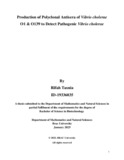| dc.contributor.advisor | Mahmud, Zahid Hayat | |
| dc.contributor.advisor | Naser, Iftekhar Bin | |
| dc.contributor.author | Tasnia, Rifah | |
| dc.date.accessioned | 2023-05-15T03:57:04Z | |
| dc.date.available | 2023-05-15T03:57:04Z | |
| dc.date.copyright | 2023 | |
| dc.date.issued | 2023-01 | |
| dc.identifier.other | ID 18126028 | |
| dc.identifier.uri | http://hdl.handle.net/10361/18282 | |
| dc.description | This thesis is submitted in partial fulfillment of the requirements for the degree of Bachelor of Science in Biotechnology 2023. | en_US |
| dc.description | Catalogued from PDF version of thesis. | |
| dc.description | Includes bibliographical references (pages 81-90). | |
| dc.description.abstract | Cholera is endemic in Bangladesh due to serogroup O1, and people are still suffering from the disease seasonally in this geographic area. So, detecting the disease as soon as possible and making availability of materials to detect the disease is indispensable. Anti-sera are used to identify the serogroup of pathogenic Vibrio cholerae. Anti-sera are available commercially, but they are expensive, and getting the substance to the lab can take time. Thus, making antisera in the lab can be time and money efficient and can help local labs become self-sufficient. The purpose of this study and process was to show how to make the anti-sera on-site in the labs. The pathogenic strain of V. cholerae can be identified more quickly by utilizing V. cholerae antisera. The methods for recognizing V. cholerae serotype O1 and O139 are crucial as it is sensitive as well as repeatable because up to 60%-75% of all cholera cases are subclinical. During the study, the samples were taken from an area around ponds at a camp for Rohingya refugees where 42 suspected Vibrio were isolated using the common culture method. 26 of them had gelatinase activity and were oxidase positive. Based on colony morphology and gelatinase activity, isolates were obtained. On each isolate, common biochemical tests designed to identify Vibrio were conducted. 18 samples were determined to be Vibrio cholerae after conducting common biochemical tests. For molecular confirmation, multiplex PCR was then performed. ToxR genes were present in 18 of the isolates, but the lack of ctxA genes indicated that they were nonpathogenic O1/O139. To validate the findings and the prepared anti-sera the lab-prepared polyclonal antiserum was used where 3 samples agglutinated with the anti-sera confirming that they were nonpathogenic O139 Vibrio cholerae. The polyclonal antibodies were prepared by injecting dosage of dead cells of V. cholerae to New Zealand white rabbits and following all the procedures the polyclonal antisera were prepared which was further used to identify the pathogenic O1 and O139 serogroups of V. cholerae fast and cost effectively. | en_US |
| dc.description.statementofresponsibility | Rifah Tasnia | |
| dc.format.extent | 97 pages | |
| dc.language.iso | en | en_US |
| dc.publisher | Brac University | en_US |
| dc.rights | Brac University theses are protected by copyright. They may be viewed from this source for any purpose, but reproduction or distribution in any format is prohibited without written permission. | |
| dc.subject | Vibrio cholerae | en_US |
| dc.subject | Antisera | en_US |
| dc.subject | Polyclonal | en_US |
| dc.subject | Serotypes | en_US |
| dc.subject | Environmental sample | en_US |
| dc.subject.lcsh | Cholera | |
| dc.subject.lcsh | Vibrio infections | |
| dc.title | Production of polyclonal antisera of vibrio cholerae O1 & O139 to detect pathogenic vibrio cholerae | en_US |
| dc.type | Thesis | en_US |
| dc.contributor.department | Department of Mathematics and Natural Sciences, Brac University | |
| dc.description.degree | B. Biotechnology | |

